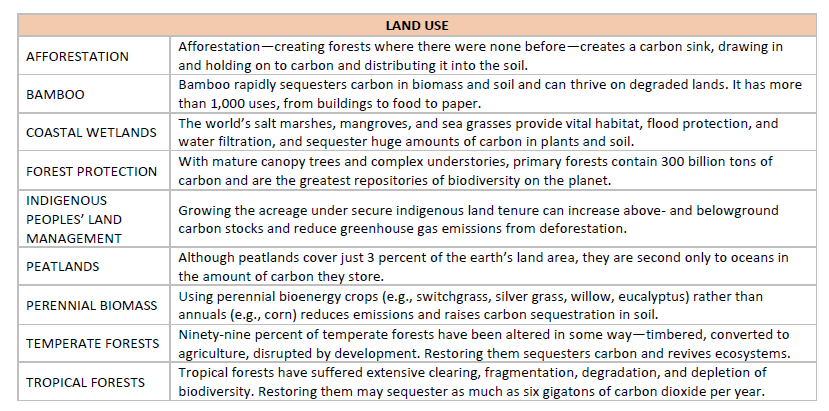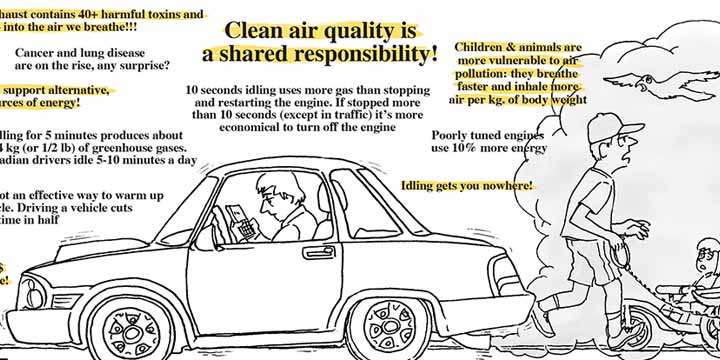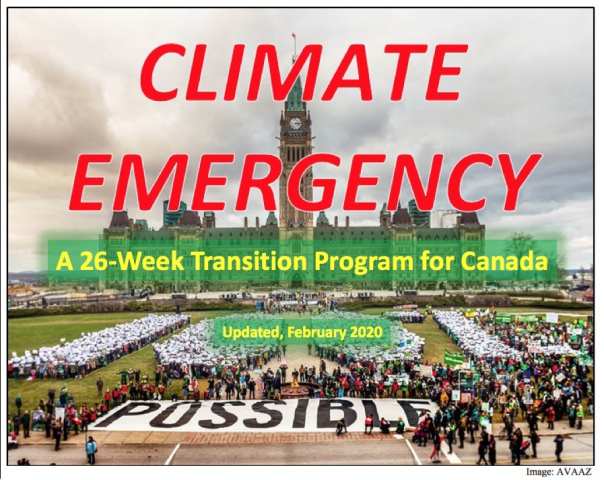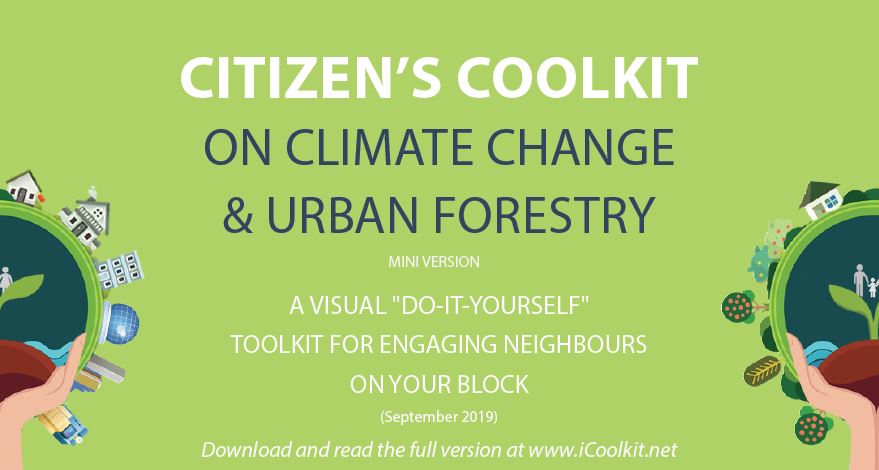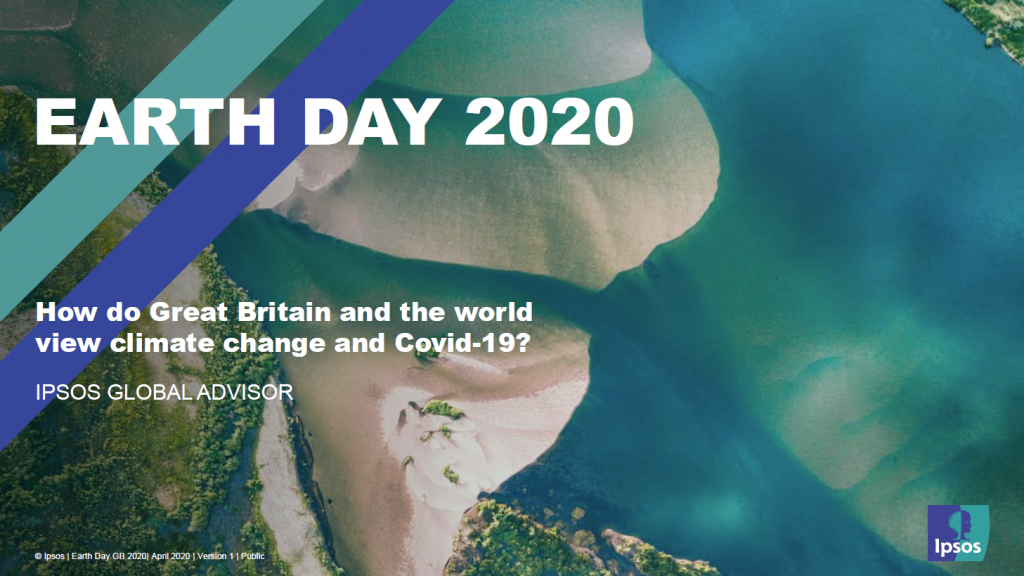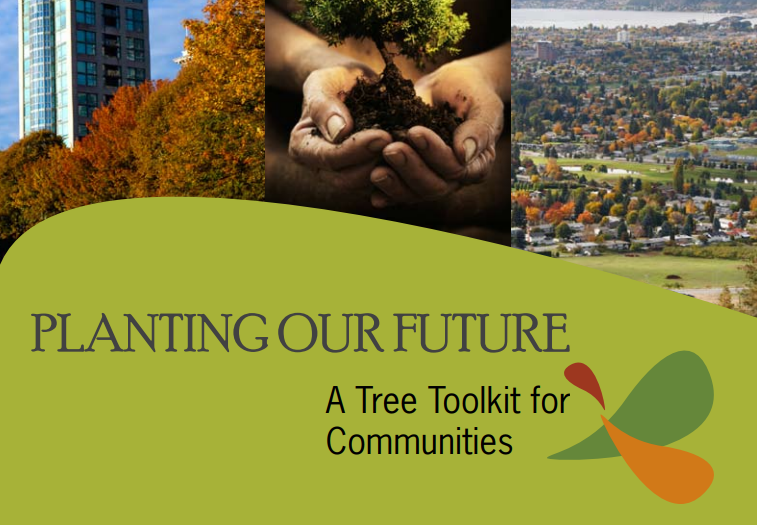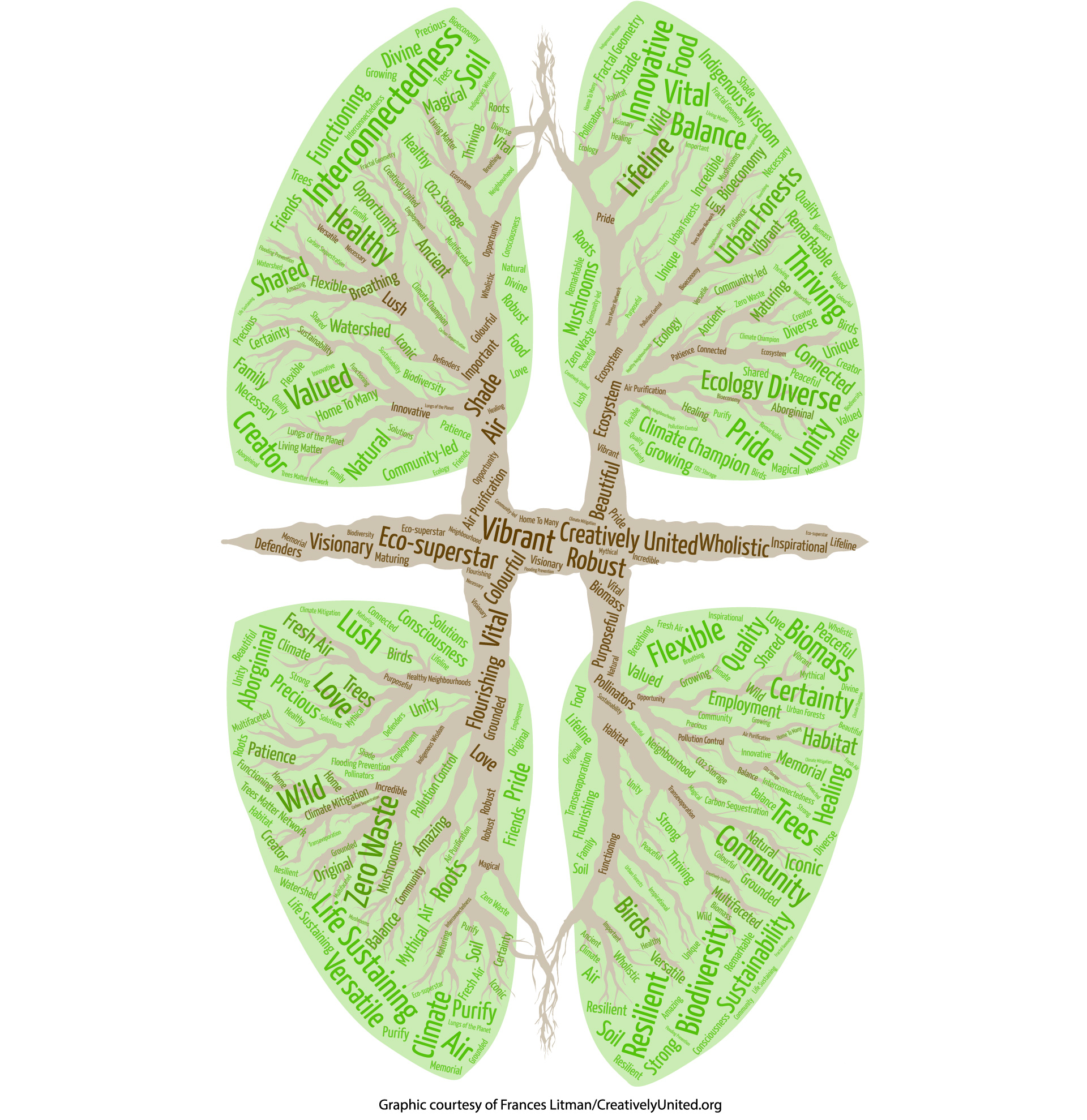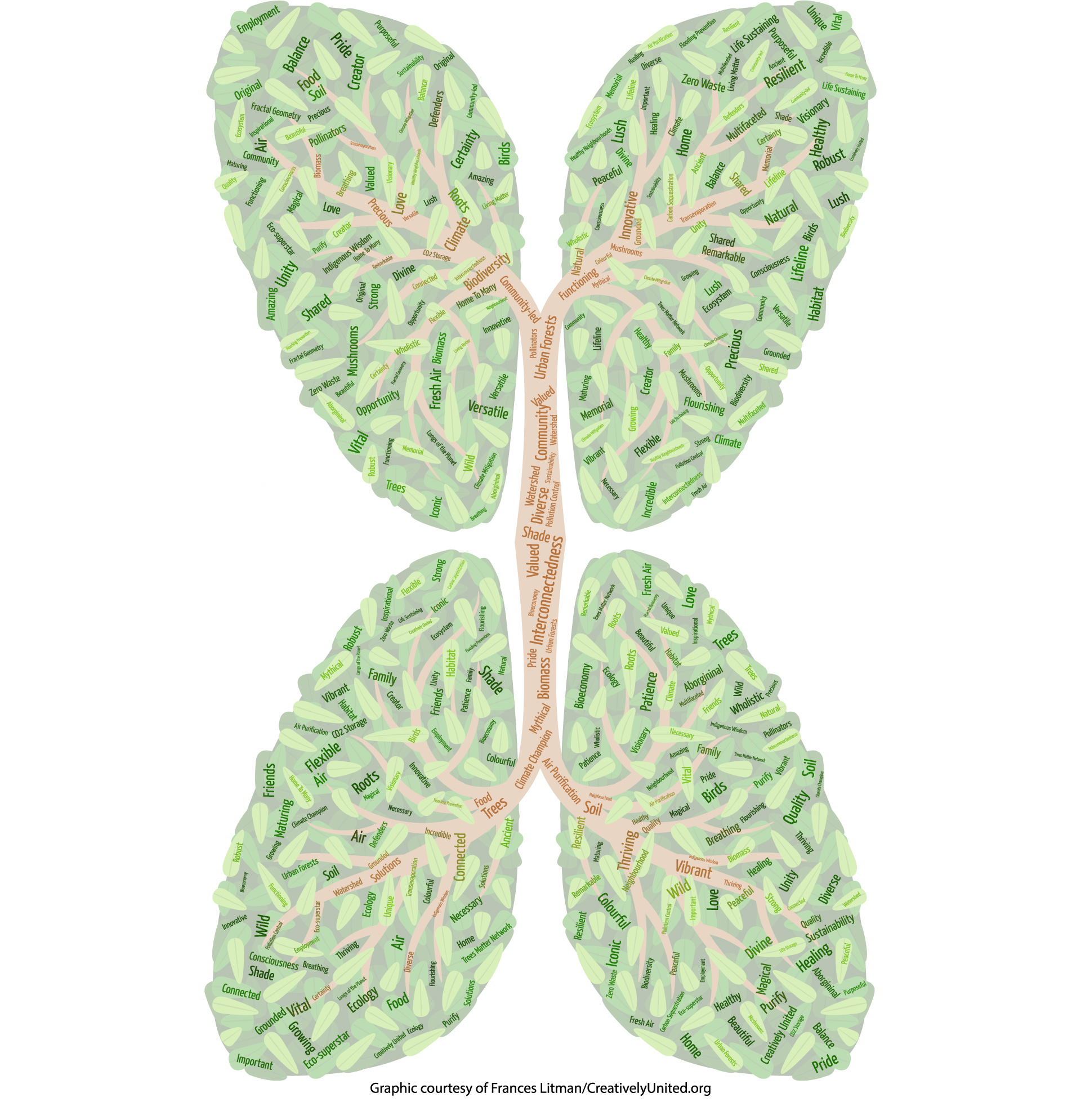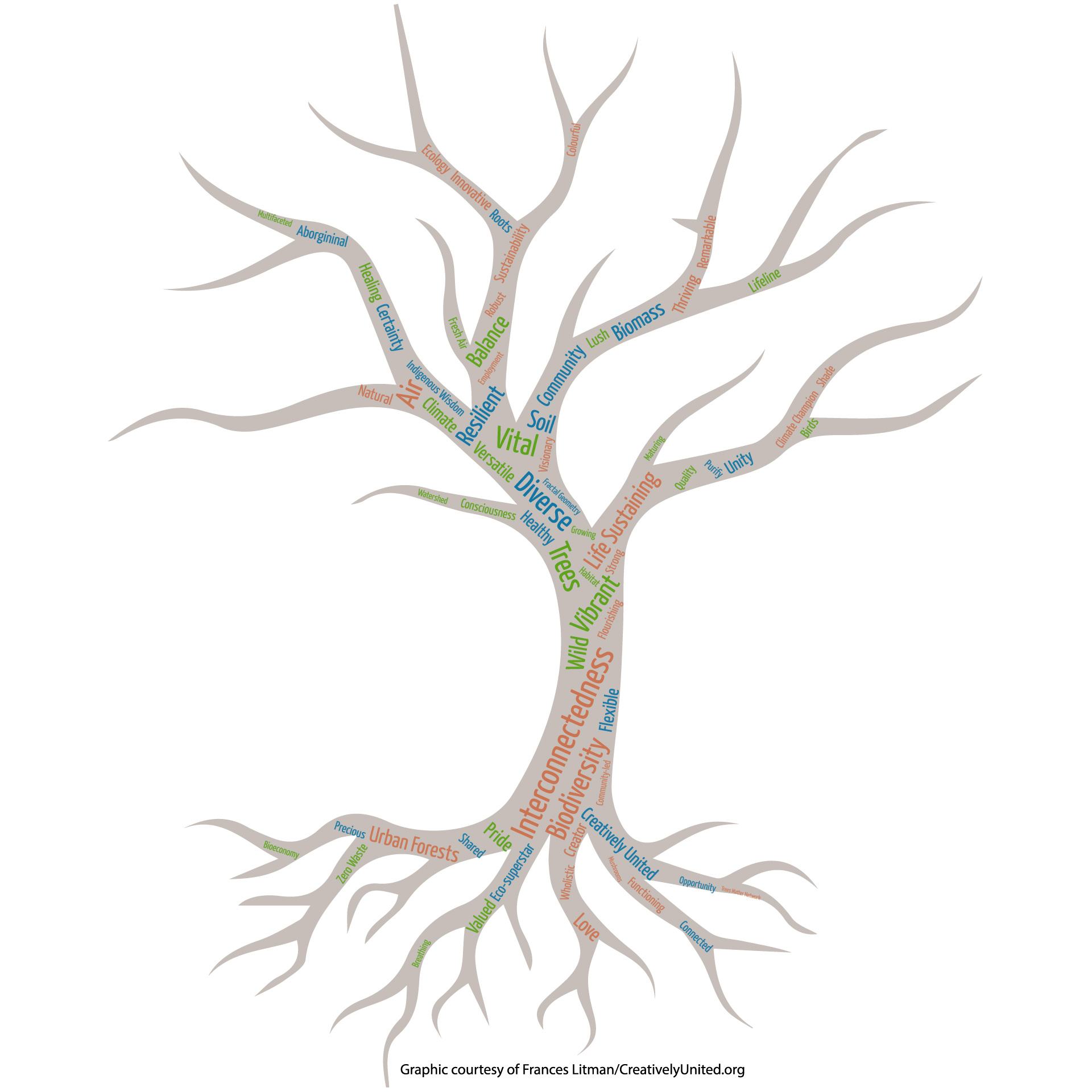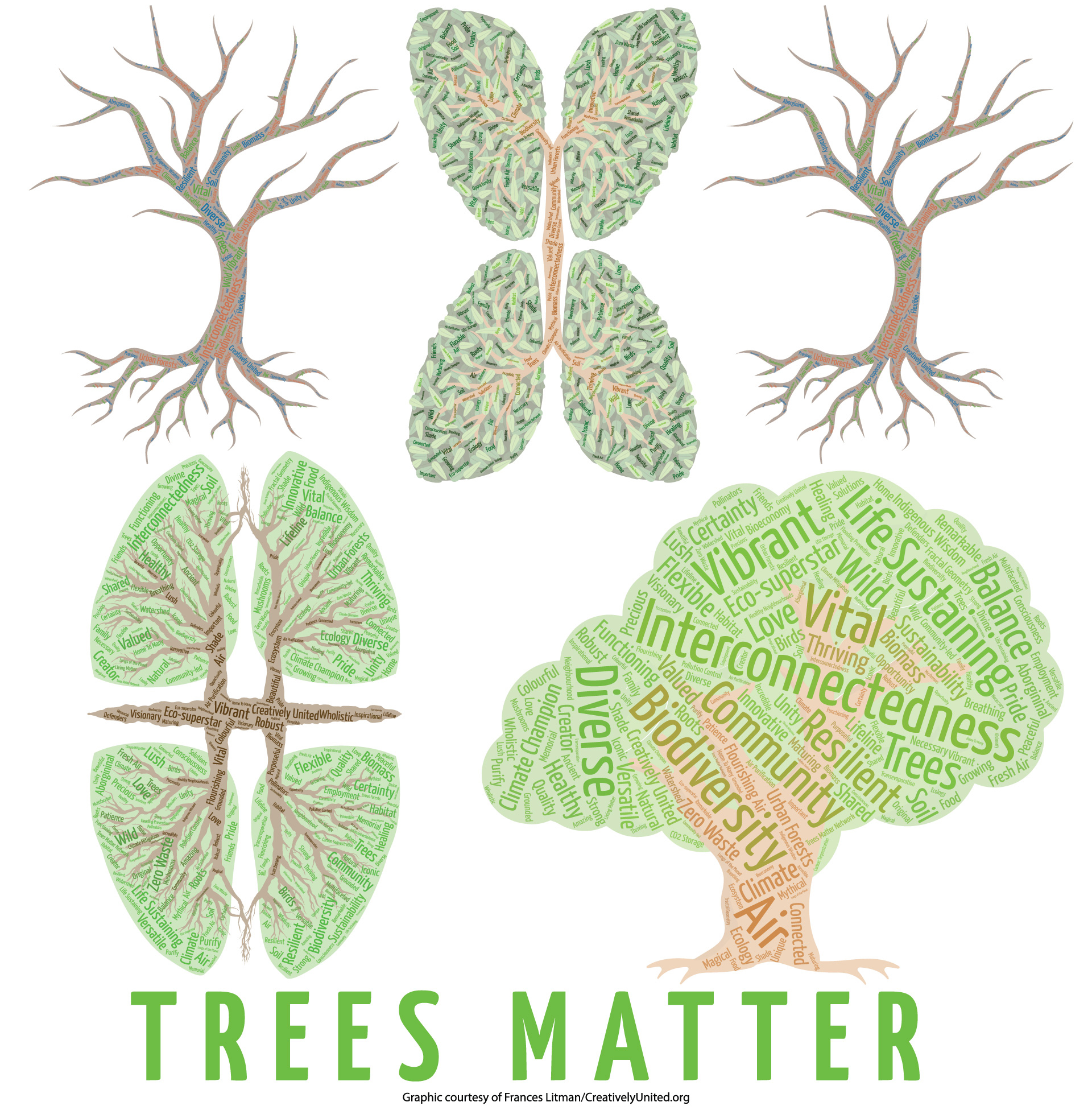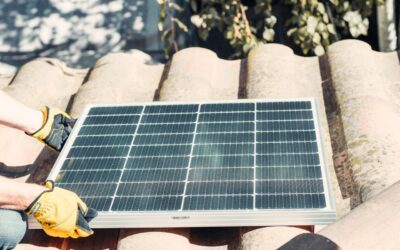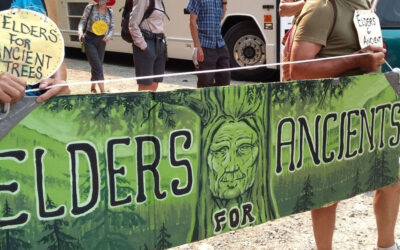Nature & Conservation
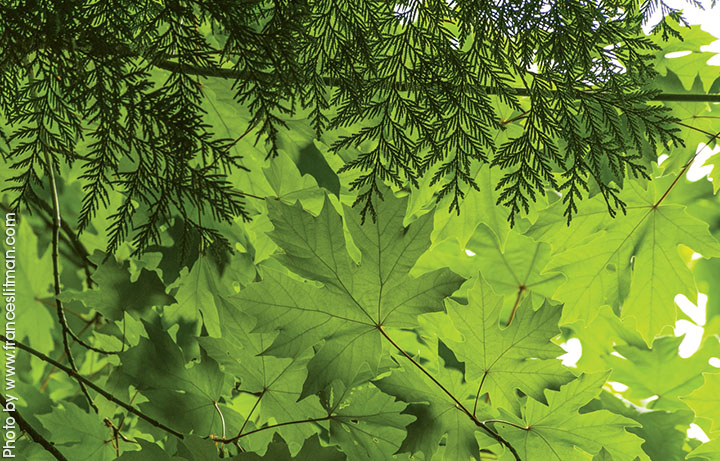
Community Trees Matter Network Toolkit
Trees matter! For this reason (and many more listed below), we have compiled a variety of information, resources, ideas and wisdom to help protect and preserve more trees. Please join us! Trees offer a multitude of benefits that many of us take for granted. Scientists are discovering that trees are a far more sophisticated and valuable living resource than we ever imagined.
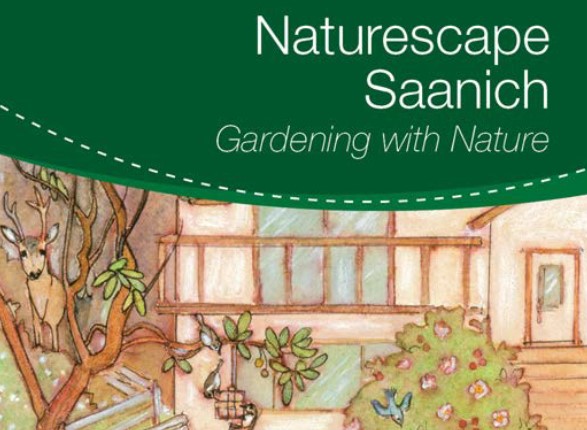
Naturescape Saanich - Gardening with Nature
Naturescape is a program and concept to protect, maintain and enhance wildlife habitat and native biodiversity. It encourages creating diversity, layers and edges and using native plants on your property and in the re-design of landscapes. Saanich Council endorsed the principles of Naturescape and a plan for implementation in 2000.
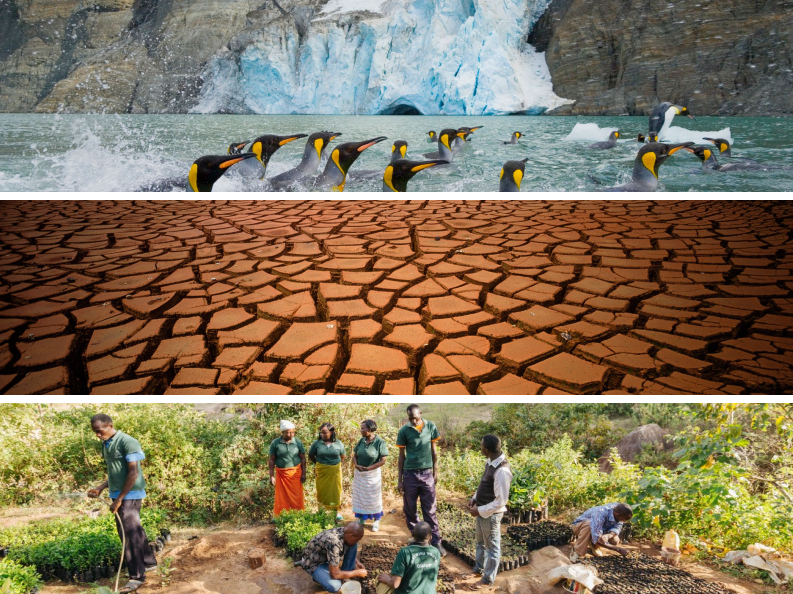
Nexus Report Nature Based Solutions to the Biodiversity and Climate Crisis
The climate change and biodiversity crises that the world faces are closely intertwined – and they cannot be seen in isolation of a pandemic causing a global ‘vulnerability experience of mankind.’ The economic impacts of the pandemic will be severe. Stimulus packages are therefore indispensable – but they need to be to be based on sustainability and climate action to increase the resilience of our societies.
Pachamama Alliance Drawdown Initiative
Dig into Drawdown solutions! Project Drawdown, an international coalition of more than 200 researchers and other experts, identified and presented the 80 most substantive solutions to global warming.
Founded by author, environmentalist, and entrepreneur Paul Hawken, the group revealed their extraordinary findings: that it is possible not just to slow global warming, but to actually begin reversing it by 2050.
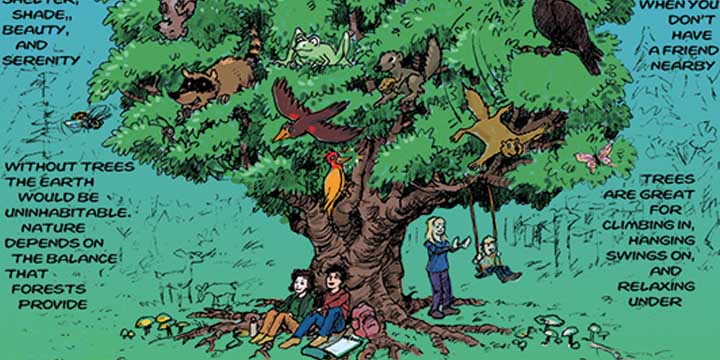
Tree Are Vital Infographic & Colouring Sheet
By Nelson Dewey
Learn why trees are so important to our lives and the health of our planet with a charming cartoon tree and facts by local artist Nelson Dewey.
Download: Infographic - Colouring Sheet
4x9 Printable Graphic

Why Environmental Groups Need Our Support
By The Creatively United for the Planet Society
These 15 reasons why environmental groups need our support will help inspire environmental awareness! Created by local cartoonist Nelson Dewey.

Cartoon Colouring Sheet
By The Creatively United for the Planet Society
Download this shareable cartoon colouring sheet created by local cartoonist Nelson Dewey.
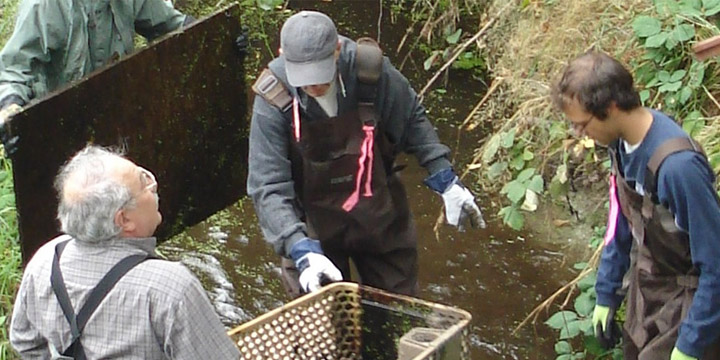
Stewardship Centre For BC Resources
SCBC offers free resources to the stewardship community. These diverse and comprehensive documents are available for your use on all of your ecological projects.
Learn More
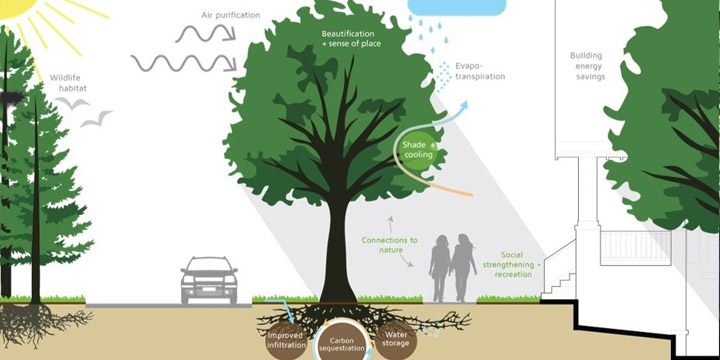
The Urban Forest
Victoria’s urban forest is a diverse landscape comprised of a variety of tree species, shrubs, groundcover and the vital living ecosystems of the soils in which they grow.
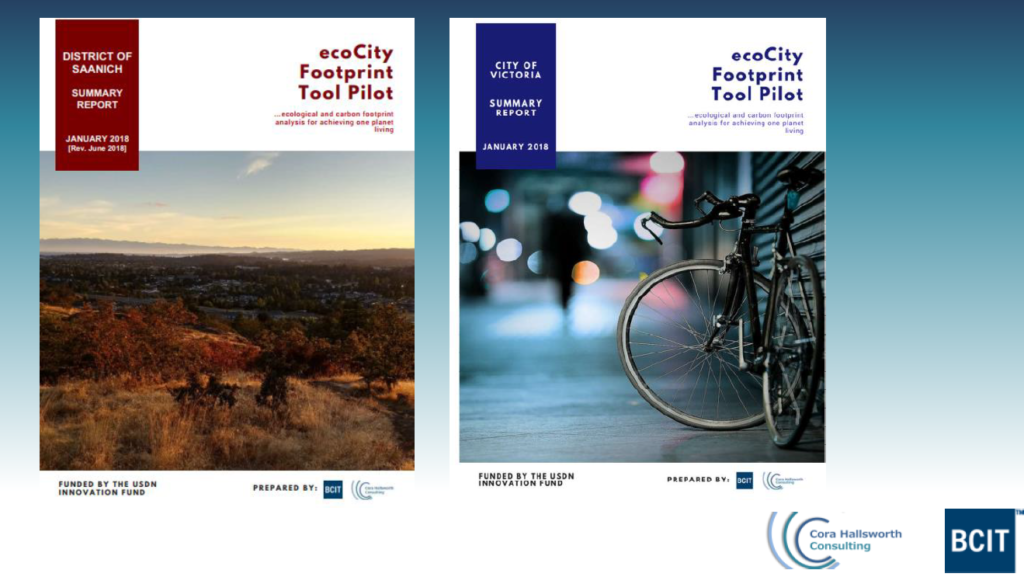
One Planet Saanich EcoCity Footprint
By Cora Hallsworth/Saanich
The summary report of Saanich's ecological and carbon footprint analysis for achieving one planet living.

Top 5 Water Challenges in BC
By The POLIS Project (UVic)
British Columbia’s past, present, and future are intertwined with water. Lakes, rivers, aquifers, and glaciers were—and remain—critical to Indigenous populations in all aspects of life, and were important to early settlers for transport and resource development. More recently, development in British Columbia has included the damming of rivers and creation of a vast network of hydropower—now the source of 90 per cent of the province’s electricity.
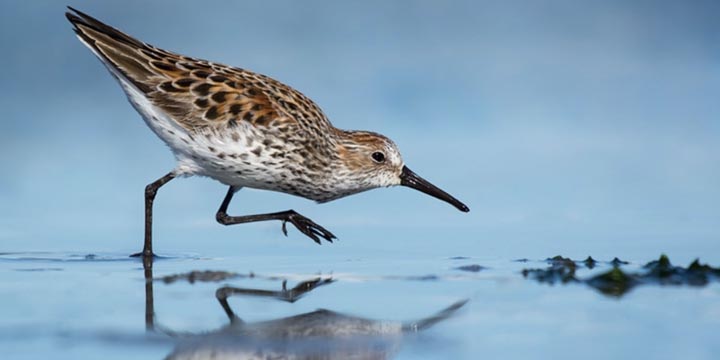
Urban Sanctuary Project
The Urban Sanctuary Project is a community initiative that aims to inspire others to become involved in the practices of a healthy ecosystem, with a special focus on Migratory Bird Sanctuaries. Celebrating the first three Migratory Bird Sanctuaries in Pacific Canada, in the heart of the Salish Sea, 2017 will mark the 100th anniversary of the Migratory Bird Convention Act, an important step in the history of the Canadian wildlife conservation movement.
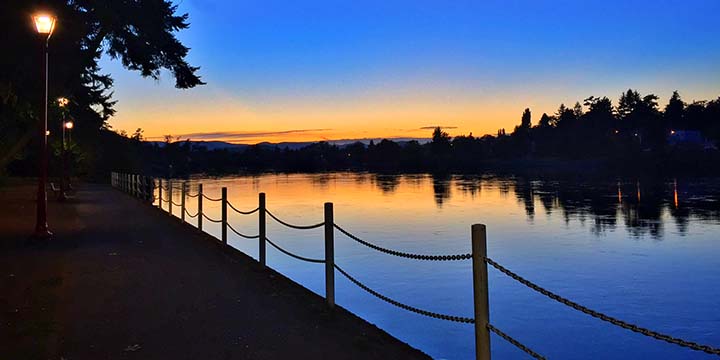
The Need To Protect The Gorge Waterway
By UVIC Environmental Law Centre
This document raises a concern that local governments are failing to protect Gorge Waterfront public lands from private use and occupation. In this report we ask the governments of Esquimalt and Saanich to investigate which public assets may, or may not, have been lost or compromised.
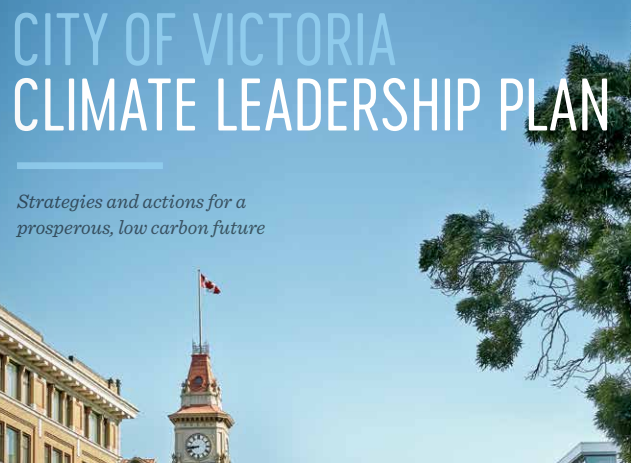
Victoria's Climate Leadership Plan
Learn about the goals and targets behind the CLP’s five sectors – Buildings, Mobility, Waste, Municipal Operations and Adapting Early – and the important role that all Victorians must play as we work together towards a prosperous, low carbon future.
Climate Emergency: A 26-Week Transition Program for Canada
By Guy Dauncey
This is a practical, down to earth concrete step by step transition strategy for the Canadian government to get real about the climate emergency. A must read for all Canadians to make a difference and communicate to their elected officials new policies and programs that will make a difference now.
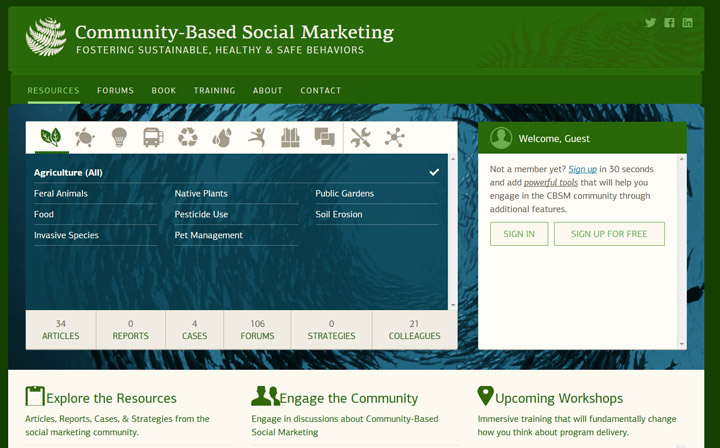
Community Based Social Marketing
Community-Based Social Marketing is helping humanity make this transition more gracefully. The cornerstone of sustainable and healthy communities is behaviour change. Sustainability requires that individuals and businesses engage in diverse actions, such as reducing waste, increasing water and energy efficiency, altering transportation habits, and protecting native species. Healthy lifestyles require individuals to make smart food choices, exercise, avoid smoking and excessive sun exposure, and engage in a myriad of other actions.
Citizens Coolkit on Climate Change & Urban Forestry
This booklet aims to help you climate-proof your neighbourhood while improving the urban forests that surround your home. This booklet is full of fun tools and hands-on activities that are organized into 5 steps: chatting, mapping, rating, visioning and acting. These activities aim to help you see your neighbourhood in a new way, make climate change visible, and re-imagine your future. Pick the activities that you find the most interesting - or do them all if you wish!
International Ipsos Global Advisor Survey - Climate Change
Seven in ten consider climate change as serious a crisis as Covid-19, and a similar proportion feel their government will be failing them if it doesn’t act on climate change now. Two thirds globally support a green economic recovery from the crisis.
Planting Our Future - A Tree Toolkit for Communities
Although this document was created in 2008, the information remains relevant and provides useful planning tools and strategies that can be used to help communities to enhance the value of their urban forest. The benefits of trees are clearly listed, issues and challenges are addressed, and straightforward suggestions are provided.
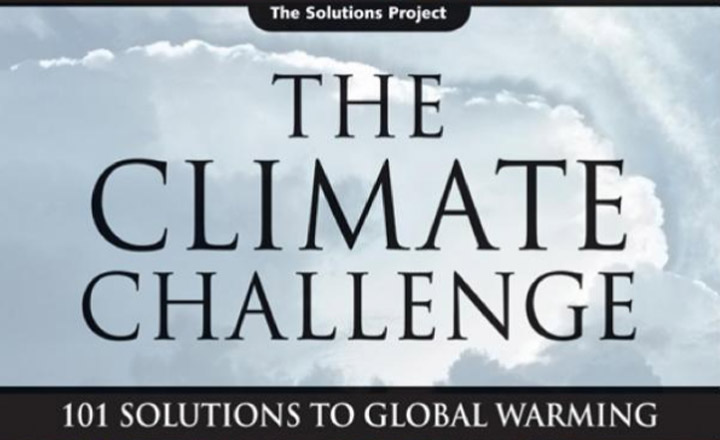
The Climate Challenge
by Guy Dauncey
The Climate Challenge draws on working solutions from around the world, and lays out the best actions for students and scientists, musicians and mayors, policy-makers and presidents, showing how it is possible to reduce our carbon footprint to almost zero by 2040. Each solution describes steps that are already being used in homes, schools, businesses, cities, and governments around the world-with full scientific references to help the reader dig deeper and push farther.
Reading List
Courtesy of Guy Daucney
Drawdown: The Most Comprehensive Plan Ever Proposed to Reverse Global Warming, by Paul Hawken (2017)
Designing Climate Solutions: A Policy Guide for Low-Carbon Energy, by Hal Harvey (2018)
This is Not a Drill: The Extinction Rebellion Handbook (2019)
No One is Too Small to Make a Difference, by Greta Thunberg (2019)
The Citizen’s Guide to Climate Success: Overcoming Myths that Hinder Progress, by Mark Jaccard (2020)
Our House is On Fire: Scenes of a Family and a Planet in Crisis, by Greta Thunberg et al (2020)
Live Green: 52 Steps for a More Sustainable Life, by Jen Chillingsworth (2019)
Trees Matter Shareable Graphics
Trees are among the hardest working members of our world community. Every day, 24 hours a day, they provide a huge host of incredible services that they receive little thanks or recognition for. Frances Litman created these graphics to visually show some of the many attributes of trees. Please feel free to share these graphics in support of the trees in your neighbourhood.
Be Inspired By The Natural World
Watch interesting and engaging videos from people doing hero work for our natural world
Quick Tips
- Attend national or international conferences by video-link
- Plant trees
- Plant native plants
- Control invasive species
- Grow vegetables on your patio or balcony
- Attract pollinators and/or keep bees
- Measure your carbon footprint using the Saanich Carbon Calculator
- Don’t wash your car until fall rains begin
- Hand water your lawn and plants
- Brush your teeth without letting the water run and make showers as quick as possible
- Install low-flush toilets in new or renovated bathrooms
- Buy tree-free or 100% recycled paper, tissues, toilet-paper
- Wash clothes with full loads and in cold water
- Switch to an electric mower, weed-eater, chainsaw
Fall in Love with Nature’s Beauty
 Get out for a walk in the woods. Stroll down to the beach. Take in a sunset or stay up to catch the striking occurrence of a shooting star.
Get out for a walk in the woods. Stroll down to the beach. Take in a sunset or stay up to catch the striking occurrence of a shooting star.
There are many opportunities to fall in love with nature’s beauty; it doesn’t have to be a complicated love story.
The best of nature’s teachings are that the simple things in life are worth watching out for. Did you happen to notice that tree you just walked by? Did you hear birds chirping? Or, have you stopped to enjoy the simple beauty of clouds against a blue sky?
Believing in the power of the natural world and noticing its charm aligns us with what’s important in life. That’s why nature’s beauty is a love story worth falling for.
Restore a Climate Friendly World
We have a great opportunity to shift our world into one that is lighter on our environment. Climate justice is a term that has been shared widely on this topic. It refers to our climate state being a political and ethical matter (not just an environmental one). We understand through this that how we treat our planet is a moral and personal issue.
Pause for a moment to check-in with your values. Do you treat the environment with the same care as you would treat a good friend? Do you think about how your actions are affecting the earth? Have you considered that what we do on our planet today will be inherited by our children tomorrow?
When creating a climate friendly world, we must make friends with our planet first. By creating changes in our own lives we encourage climate restoration, but we also must think bigger. We must take the conversation into our homes to discuss with our families and bring them forward to our governments.
Adopt a One Planet Approach
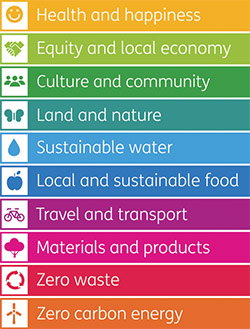 North Americans are consuming and living as though we have the resources of five planets*. Since we only have this one planet — to meet our needs and those of future generations — we must do more to reduce our consumption and its resources.
North Americans are consuming and living as though we have the resources of five planets*. Since we only have this one planet — to meet our needs and those of future generations — we must do more to reduce our consumption and its resources.
We are at a point in our history where we must consider every aspect of our daily lives and adjust our consumption to live within our planet’s capacity.
As we set economic, social, and environmental goals, a one planet approach means that we commit to practices that are within the planet’s boundaries of sustainability. However, we must first understand that our self-interests must be aligned with the health of the community and humanity as a whole, and the economy must be grounded in nature’s principles. We can then engage with our local, provincial, and federal governments to set feasible targets to achieve our goals.
With concerns for our climate growing, we are seeing a greater number of community groups forming to accelerate the change that needs to happen.
Bioregional is a global organization that has created the One Planet Living® sustainability framework that has been adopted by a growing number of Saanich-based organizations in Victoria, BC. The Creatively United for the Planet Society is one of more than a dozen integrators.
The above graphic illustrates the key areas of the framework. By uniting the wisdom of businesses, individuals, indigenous knowledge, and government policy, we can create an alliance that respects the capacity of the planet we live on.
*Source: Footprintnetwork.org, Overshootday.org
Protect Farmland & Create Urban Farm Landscapes
 The interest in locally grown, nutritiously rich, organic food is growing significantly. However, farms, food trees, and land are rapidly disappearing and many people do not have access to local and cultural food or adequate healthy food and must rely on emergency food services.
The interest in locally grown, nutritiously rich, organic food is growing significantly. However, farms, food trees, and land are rapidly disappearing and many people do not have access to local and cultural food or adequate healthy food and must rely on emergency food services.
“Less than 50% of people on the island consume their daily recommended fruit and vegetables (Canada Food Guide), over 50% of people are overweight or obese, and the prevalence of diet related disease and chronic illness (diabetes, hypertension, cardiovascular disease) continues to rise.” (Source: Good Food Network Report 2025)
As we make a stand for local food security, we must learn how we, as individuals and communities, can protect the future of agricultural land.
Here’s a few ways you can protect farmland:
- Buy from local farmers.
- Resist shopping at big box stores (forests and farmland often are paved over for these stores).
- Support government policy that invests in farmers.
- Encourage and support younger generations interested in farming.
- Review the Good Food Network Report 2025 guide available on www.goodfoodnetwork.info and the CreativelyUnited.org Resources page. It’s an example of a solutions-based framework that leverages significant health, environmental, and economic benefits through food system initiatives that increase food security. It also addresses access to safe, healthy, and culturally appropriate food that honours traditional ways of hunting, gathering and fishing by indigenous peoples.
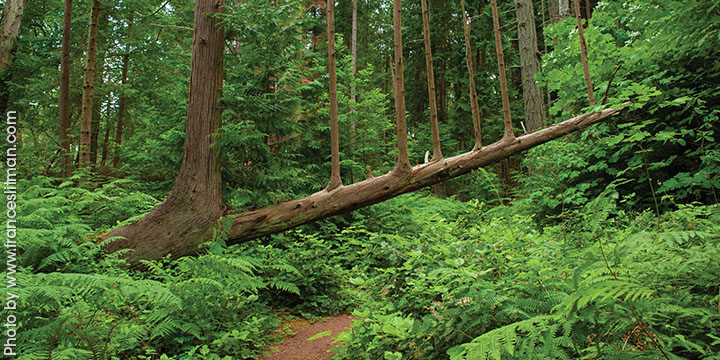
Cultivate Bee Loving Spaces
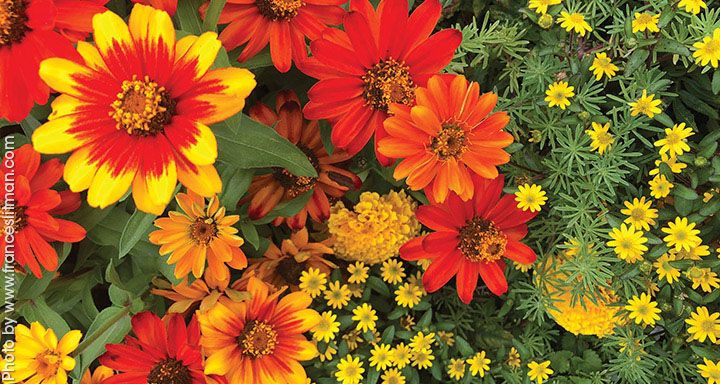 One of the most crucial creatures to the web of life is the humble bee. Sadly their numbers have dwindled over the years due to pesticides and climate change. These hardworking pollinators help trees, flowers, and plants survive and thrive, contributing daily to our food supply and economic resilience.
One of the most crucial creatures to the web of life is the humble bee. Sadly their numbers have dwindled over the years due to pesticides and climate change. These hardworking pollinators help trees, flowers, and plants survive and thrive, contributing daily to our food supply and economic resilience.
Here’s a few ways to cultivate bee-loving spaces:
- Do not use herbicides, insecticides or pesticides as they kill bees and other pollinators.
- Leave room for bees. Some bees nest in the ground and require patches of bare earth, as well as dead plant stems for nesting.
- Plant flowers! When luring bees, you want to plant groupings of flowers so that they can feed rapidly with shorter distances to travel between blooms.
- Build a bee home. You can create a mason bee home or native bee home from scratch! There are many resources on the internet to help you get started. Try searching for Mason Bee homes.
- Create a bee bath – a shallow plate with a few rocks in it and a little water will do.
- Invest in native plants as there are certain bees that only harvest pollen from plants that are native to the region.
Love Your Ocean
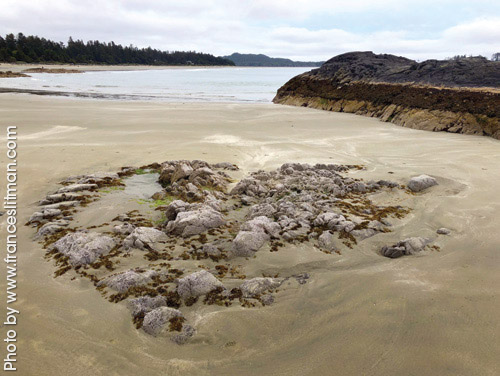 Did you know that oceans cover 70 per cent of the Earth’s surface and produce half of the world’s oxygen thanks to phytoplankton, kelp and algal plankton?
Did you know that oceans cover 70 per cent of the Earth’s surface and produce half of the world’s oxygen thanks to phytoplankton, kelp and algal plankton?
Quick Ocean Facts:
- The majority of life on Earth is aquatic.
- 94% of the Earth’s species exist within the oceans.
- Oceans regulate climate and weather patterns by transporting heat from the equator to the polls.
- Oceans absorb carbon dioxide from our atmosphere.
- We rely on oceans for food, transportation, tourism, leisure and industry.
- The largest ocean on Earth is the Pacific Ocean, it covers around 30% of the Earth’s surface and contains more than 25,000 different islands.
- The second largest ocean is the Atlantic Ocean, it covers over 21% of the Earth’s surface.
- The third largest ocean is the Indian Ocean, it covers around 14% of the Earth’s surface.
Ocean Pollution Facts:
It is estimated that 80 per cent of marine litter makes its way to the ocean gradually from land-based sources via storm drains, sewers, and other routes. The majority of the garbage that enters the ocean each year is plastic.
Other pollutants include:
- Oil from boats, airplanes, cars, trucks, and lawn mowers.
- Chemical discharges from factories, raw sewage overflow from water treatment systems, and stormwater and agricultural runoff.
- Toxic by-products from the oil and gas industry’s routine operations.
- Noise from ships, oil and gas exploration, military exercises.
Sound waves travel farther and faster in the sea’s dark depths than they do in the air, and many marine mammals like whales and dolphins, in addition to fish and other sea creatures, rely on communication by sound to find food, mate, and navigate. But an increasing barrage of human-generated ocean noise pollution is altering the underwater acoustic landscape, harming, and even killing, marine species worldwide. Source: nrdc.org
SOLUTIONS:
In order to protect our oceans and their inhabitants (not to mention ourselves), we must think about how we use them and advocate for them. With all streams flowing to rivers and all rivers leading to the sea—oceans are the end point for so much of the pollution we produce on land regardless of where it is produced.
By considering all the ways our lifestyle can impact oceans we can begin to lighten our footprint and collectively make a difference.
Knowing that everything we put down the drain may end up in the sea, we can begin by simply replacing harsh cleaning products with these lighter alternatives:
- Baking soda
- Lemon juice
- Borax
- Vinegar
- Essential oils
- Salt
- Hydrogen peroxide
- Liquid castile soap
Check out Surfrider.org. From legendary beach clean ups to educational campaigns about alternatives to plastics, they are a powerful activist network that brings awareness to the issues facing our ocean.
Sources: nrdc.org, Sciencekids
Celebrate Clean and Green
 When it’s celebration time, remember there are lighter solutions to how we observe special occasions. Did you ever stop to wonder how we could begin to shift traditional decorations into more conscious ones?
When it’s celebration time, remember there are lighter solutions to how we observe special occasions. Did you ever stop to wonder how we could begin to shift traditional decorations into more conscious ones?
Here are a few alternatives that add to the celebration:
- Bubbles not Balloons – Balloons create more plastic in our environment and have the potential to harm birds, fish and animals that might consume them. Instead, choose a biodegradable soap and have fun blowing bubbles instead!
- Birdseed Confetti – Use birdseed or rice as confetti instead of littering the streets with paper or plastic.
- Use Recycled Wrap & Gift Bags – Save wrappings and gift bags that others gift to you and reuse them.
- Use Nature to Decorate – Instead of purchasing decorations that will take up space in our landfills, thoughtfully use nature instead. Flowers and tree branches make unique and delightful centrepieces.
- Quality Time – There’s a tendency to believe that to show love or appreciation, we must buy each other more things. However, a meaningful gift that may be worn, eaten or put to good use at home or work has more value, as does spending quality time and enjoying experiences together.
- Rethink Fireworks – Fireworks cause extensive air pollution in a short amount of time, leaving metal particles, dangerous toxins, harmful chemicals, and smoke in the air for hours and days. Some of the toxins never fully decompose or disintegrate, but stay in the environment, contaminating soil and water.
Fireworks also have an adverse effect on birds, butterflies, small mammals, and wild and domestic animals. Fear often causes animals to flee into roadways, which results in more vehicle damage and dead animals. - Bring Your Own Dishes & Cutlery – When packing up your contribution to a potluck or party, consider bringing your own dishes, cutlery, cloth napkins and glassware. Not only does this make it easier on the host of the party with clean up, but it avoids adding garbage to the landfill. Composting of food waste and paper will also help reduce unnecessary garbage.
Sources: Terrapass.com and Westsoundwildlife.org, babywarm.org
Green Your Travel
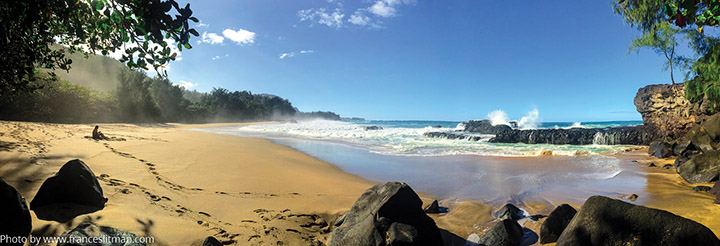
Greta Thunberg showed the world that options to flying exist by crossing the Atlantic ocean in a sailboat instead of flying. While not everyone can jump on a sailboat to their next destination, we can reduce our travel footprint by:
- Discovering unique places closer to home instead of flying abroad.
- Refusing plastic on flights by refilling your own large bottle of water just prior to boarding your flight and reducing in-flight consumption.
- Staying in one location for an extended period of time and thoroughly exploring that destination on foot, bike, bus, electric vehicles and minimizing vehicle travel by planning trips carefully.
- Supporting local small scale businesses, smaller boutique hotels, and privately owned rentals where there is a limit on the size of the development and sustainability is practiced.
- Minimizing towel washing, long showers, baths, linen and towel changes.
- Volunteering for social and environmental projects at your destination.
- Supporting farmers markets and local artisans by buying locally produced food, goods and services.
- Be respectful by reducing your waste. Compost and recycle as much as you can.
- Invest in offsets by making donations of time, expertise and/or funds with grassroot organizations and charities who stand for what you value.
- Check out organizations like the Rainforest Alliance who are focused on educating the public on how to transform their travel into an adventure that benefits all.

Adopt a Tree or Many!
Trees offer a multitude of benefits that many of us take for granted. Scientists are now discovering that trees are far more sophisticated and valuable as a living resource than we ever imagined.
Here are just a few of the many benefits trees offer:
- Trees give us food, fruit, medicine, shelter, shade, beauty and serenity.
- Without trees the Earth would be uninhabitable by humans.
- Trees are the planet’s lungs and good for our lungs. Trees breathe out oxygen, we breathe in purified air.
- Trees clean and purify air and create fertile soil.
- Residents living on streets with mature trees have reduced levels of asthma.
- Trees provide habitat for wildlife, endangered species, insects, other plant life and people.
- Trees increase neighbourhood pride, provide a sense of place and have historical significance.
- Trees have significant economic value and increase real-estate values by 3-15%. Neighbourhoods with mature trees are generally the highest priced neighbourhoods.
- Treed commercial areas encourage customers to linger and shop at local businesses.
- Tree roots bind the soil and fight erosion by shielding it from the drying effects of wind and sun.
- Trees help people save money on energy bills by providing cooling shade in summer and breaking the wind in winter.
- In addition to providing cooling shade (up to 10 degrees less), trees are constantly transpiring a fine mist of water pulled up by the roots that then cools and freshens the air.
- A mature oak can transpire as much as 100 gallons of water a day.
- Tree shade is better ecologically than shade from a building because leaves filter rather than block light, allowing understory plants to grow.
- Trees store carbon and help regulate global warming. Protecting mature trees and planting new trees is the number one way to help mitigate climate change.
- Trees maximize watershed health, biodiversity, and conservation of sensitive ecosystems.
- Trees offer privacy from neighbours and buildings.
- Cutting mature and old growth trees severely disrupts nature’s balance by destroying long-established, nutrient-rich ecosystems that support food systems and habitats. Nature depends on the balance that forests provide.
- Mosses and mushrooms that inhabit the soil around trees are said to interconnect forests as part of an organic communications network.
- Trees provide food and habitat to thousands of species, especially birds. Oak trees support more species of moths and butterflies than any other tree, thus providing food for all types of birds.
- Trees stimulate our senses by offering beauty to our eyes and music to our ears with the sights and sounds of birds, beautiful designs, foliage, etc.
- Trees make wonderful living memorials to honour loved ones.
- Trees offer protection from heat, wind, rain and noisy traffic or neighbours.
- Trees filter pollutants and absorb storm water runoff, reducing the cost of storm water management in communities.
- Trees make communities safer and contribute to fewer traffic accidents by providing a calming effect that results in less crime and reduced traffic speeds.
- By shading asphalt and other dark surfaces, trees cool the urban area allowing the asphalt to last 10-25 years longer.
- Trees are the hardest working, non-paid labourer on the planet, working 24/7, 365 days a year creating all the benefits listed above and more!
- Trees are great for relaxing under and peaceful to be around.
- Trees are perfect for hugging when you don’t have a friend nearby.
Size Matters! Facts About Mature Trees
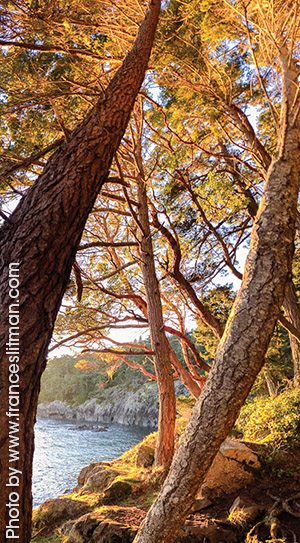 There is no substitute for mature trees. It can take up to 200 saplings to create the climate benefits of one mature tree. Maximum benefits to natural ecosystems come from larger, older trees with sizeable root and canopy masses.
There is no substitute for mature trees. It can take up to 200 saplings to create the climate benefits of one mature tree. Maximum benefits to natural ecosystems come from larger, older trees with sizeable root and canopy masses.
Mature trees are the most resilient. They have withstood the test of time, weather, and humans. Despite being damaged by cars, roads and other extreme events, mature trees should be championed and protected.
Healthy mature trees, including those more than 100 years old, can often survive extreme storms and do not have to be removed if their damaged limbs are properly pruned and given time to recover.
Mature trees increase property values. Often the most coveted places to live are those neighbourhoods with the most mature trees.
One of the biggest reasons why mature trees fall or fail is due to improper planting and pruning, according to arborist and municipal urban forester, Ryan Senechal, who advocates for protecting and preserving mature trees.
“The single greatest impact to the urban forest comes from the incremental loss of green space associated with development and densification. In addition to removal of large mature trees, there is a loss of soils and space that could be used for future generations of trees.”
-City of Victoria Urban Forest Master Plan (2013)
It’s a Myth that Mature Trees Should be Feared
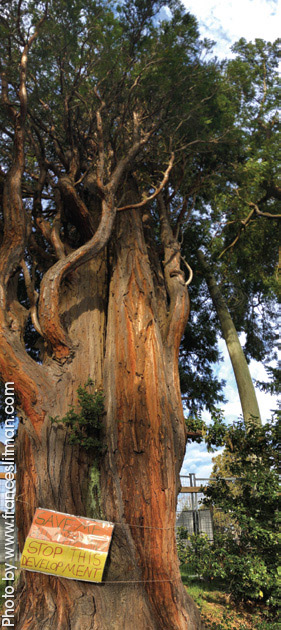 According to Christopher Roddick, author of The Tree Care Primer and head arborist at the Brooklyn Botanic Garden, “planting new trees is a fantastic ambition; the old saying goes that the best time to plant a tree was 20 years ago, and the second best time is today. But it can take 25 to 30 years before a new tree is large enough to start giving a return on ecosystem service investments: the environmental costs associated with growing and planting a tree are far greater than those the tree provides until the tree has reached a certain age, size, and output level.”
According to Christopher Roddick, author of The Tree Care Primer and head arborist at the Brooklyn Botanic Garden, “planting new trees is a fantastic ambition; the old saying goes that the best time to plant a tree was 20 years ago, and the second best time is today. But it can take 25 to 30 years before a new tree is large enough to start giving a return on ecosystem service investments: the environmental costs associated with growing and planting a tree are far greater than those the tree provides until the tree has reached a certain age, size, and output level.”
“The sad truth is that the survival rate of new plantings in many cities is only 7-13 years on average and 30 years for suburban trees. Mature trees offer the most benefits when it comes to the environment.
Oddly enough, tree planting initiatives themselves can sometimes be a culprit in mature tree removal. City officials and builders have a far easier (and sometimes profitable) time removing older trees for development when they are allowed to simply plant multiple new trees to “replace” those chopped down. Unfortunately, given survival rates and the pace of land development, many of those new trees may never reach the point of providing a net ecological benefit, much less equalling the benefits of a mature tree.”
Roddick sums it up like this: “Ask any arborist why people hire them and, more often than not, the number one answer is fear. People do love their trees, but most call an arborist because they are afraid of big trees or big branches falling on their houses. While there are many reasons to hire a tree care professional, it’s fear that actually makes people open their wallets.
The fact is, trees do fall over and do hurt people – that’s why tree care is so important. But how afraid should we really be? The odds are much greater that a person will die falling out of bed (about 500 a year in the U.S.) than being killed by a falling tree (fewer than 50). People’s fears don’t always match the likelihood of bad things actually happening, because one of the down sides of having a large brain is also having a vast imagination.”
How to Protect Trees
- Learn more about the trees you see every day.
- Get involved with local community groups or neighbour-hood associations that advocate for trees, or start your own group.
- Follow the Community Trees Matter Network on Facebook. Stay engaged with the CreativelyUnited.org Solutions Hub by sharing information, ideas, events and resources.
- Ask your town or city about volunteering to plant trees or remove invasive species on public land.
- Attend area council meetings and ask for stronger protection of public trees and incentive programs to help maintain private trees as part of the regional climate action strategy.
- Lobby local government to buy private land to convert to public forests and parks.
- Advocate to local government to require developers to build carefully around mature trees.
- Ask your local government to fund incentive programs to reward private land owners or developers for retaining trees beyond bylaw requirements.
- Develop and maintain strong community-wide support for urban trees.
- Urge local government to manage the urban forest in a way that maximizes watershed health, biodiversity, and conservation of sensitive ecosystems.
- Ask your local government to hire experienced experts with knowledge of permaculture, conservation and landscape ecology.
- Consider creating your own legacy with the gift of a land or a tree covenant.
“Trees or wooded environments of particular value can be protected on private property by registering a tree protection or natural state covenant on the land title. Where a tree on private land is deemed to be significant, the City could also consider helping the homeowner to care for and protect the tree.
Another approach might be to provide financial incentives, such as a small reduction in municipal property tax or storm water utility bill, for people with a significant tree on their property.”
– City of Victoria Urban Forest Master Plan (2013)
Planting Tips & Tree Care
It can take up to three years of care to ensure a sapling survives and thrives. Here are a few tips to consider when planting saplings and trees from Christopher Roddick’s Tree Care Primer and municipal urban forester, Ryan Senechal:
- Think to the future and find the best possible location it could remain for decades free from human intervention (ie: telephone lines, cars, driveways, sidewalks, intended development).
- Pick a species that can establish itself quickly, is draught and pest resistant, and resilient. Trees that are native to the region and have survived the longest are generally the most resilient and the best choice.
- Be sure to research the best growing conditions for your species and pick the most appropriate location.
- Give your new tree the best chance of survival by giving it adequate soil type and volume for best outcomes in tree health and stability. Leave plenty of room for it to grow with no heavy or sustained weight on its roots zone. Protect it from being eaten or disturbed.
- The best time to plant a tree is during the dormant season when soil conditions are moist, rainfall is intermittent, and planting materials are available.
- Be sure to water and care for your tree. Early morning watering is considered best. Avoid watering the tree’s foliage or watering during the heat of the day. The first three years are critical to getting your tree established. Water and mulch are essential to its survival. Call on municipal arborists or ISA Certified Arborists for help.
- Once the young tree is established, stake to ensure a solid structural foundation and prune as required.
- Protecting the tree’s root zone and maintaining proper soil biology through mulching is critical for ensuring healthy mature trees.
- For very old or dying trees, techniques like retrenchment pruning to reduce canopy, cabling and bracing to support limbs, root monitoring, and safety evaluations become important.
Sources: Tree Care Primer by Christopher Roddick, ecolandscaping.org, City of Victoria Urban Forest Master Plan, Safe Streets
A Tip About Pruning
“It’s not as simple as knowing how to cut; it’s knowing how much, when, where, and how many times to prune that makes the decisions difficult and requires specialized training and skills,” warns Christopher Roddick, who recommends hiring a skilled arborist trained in age appropriate tree care (AATC).
Zen Your Yard Care
Want to help address climate change and reduce your emissions? Switch your gas powered mowers and blowers to quieter, smog free rechargeable battery and electric alternatives and let your friends, family, municipal authorities, lawn and yard maintenance companies know that healthy options exist.
Air and noise pollution from gas-powered lawn and yard maintenance is not only annoying to your neighbours, but is also harmful to your health and the environment.
The World Health Organization recommends that general daytime outdoor noise levels should not exceed 55 decibels (dB), however, the average gasoline powered lawnmower and leaf blower ranges between 75 and 105 dB. Considering that hearing loss occurs around 90 dB, it’s no surprise that it’s hard to escape the noise of a leaf blower or lawn mower.
Despite their small size, gas-powered lawn mowers produce excessive amounts of air pollution. According to the United States Environmental Protection Agency, a gasoline-powered lawn mower operating for an hour emits smog-forming emissions equivalent to 40 automobiles. In addition, more than 17 million gallons of fuel, mostly gasoline, is spilled each year while refuelling lawn equipment, contaminating groundwater.
Source: peoplepoweredmachines.com
Invest Responsibly
How we invest has an effect on the world we live in. We have a choice to invest responsibly and need to take the time to understand the companies we do business with.
Ask your financial institution how it supports the local economy. Do they follow zero waste management principles, offer socially responsible programs, embrace fossil free fuel alternatives with a low carbon footprint, and work with suppliers who share those values? Get to know their values and make sure they are aligned with your own.
Often, credit unions and community banks have accountability practices that larger banks do not have. With the environment and climate change being such important issues, we must educate ourselves on how our money is being used.
When we choose to entrust our money with organizations that support local businesses, non-profits, and ethical and sustainable work practices, everyone wins! So get curious and start asking questions. If it’s the right place for you to invest, they will happily share with you how they walk their talk.
Pair Up With Community Non-Profits
Connect with organizations that share your values.
Community Blog Posts
CRD Pressed to Come to a Long-Term Solution for Biosolids Management
Under pressure from the province, the CRD needs to come up with a definitive plan to deal with the mounting quantity of dried biosolids pellets at Hartland. Biosolids are the byproduct of the region’s wastewater treatment processes. As of now, the CRD says…
Our Addiction to Plastics Will Come Back to Haunt Us
Monday is Earth Day, and the theme this year is Planet vs. Plastics. This is timely, because Tuesday marks the start of a week-long session in Ottawa of the Intergovernmental Negotiating Committee on Plastic Pollution. So this week, I begin to look at the plastics industry…
Regulating Forever Chemicals in Drinking Water
Canada Proposes stricter regulations for Forever chemicals in drinking water. PFACs are indestructible chemicals which are ubiquitous in the...
A Big Idea for Climate Leadership: Colwood As a Model Municipality for Renewable Solar Energy
Introduction: Climate change presents an urgent global challenge, demanding innovative solutions at every level of society. Colwood, in its...
Site C and Water Bombers
I wrote to Elizabeth May reminding her of two of her excellent ideas that I hope she’ll continue to...
April 4th: Prayer Walk for our Sacred Ancient Forests
Join Elders for Ancient Trees on a bus trip to the Nanaimo courthouse on April 4th to show solidarity for Land Defender, Rainbow Eyes, and...
